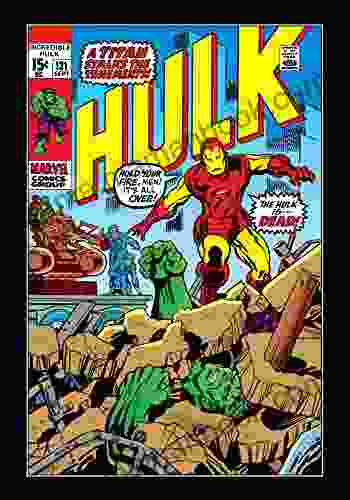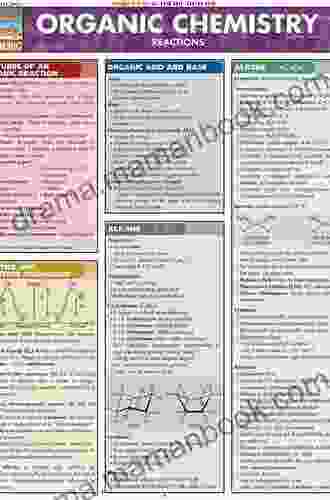Organic Chemistry Reactions: A Comprehensive Guide for Speedy Study

Organic chemistry is the study of carbon-containing compounds and their properties. It is a vast and complex field, but there are certain fundamental reactions that serve as the building blocks for more advanced concepts. This guide provides a concise overview of these essential organic chemistry reactions, with clear explanations and real-world examples to enhance your understanding. By mastering these reactions, you can lay a solid foundation for success in your organic chemistry studies.
Alkenes and Alkynes: Addition Reactions
Alkenes and alkynes are unsaturated hydrocarbons that contain double and triple bonds, respectively. They undergo a variety of addition reactions, in which new atoms or groups of atoms are added to the carbon-carbon multiple bond.
4.5 out of 5
| Language | : | English |
| File size | : | 3702 KB |
| Screen Reader | : | Supported |
| Print length | : | 5 pages |
- Hydrogenation: Addition of hydrogen (H2) to an alkene or alkyne results in the formation of a saturated alkane.
- Halogenation: Addition of a halogen (X2, where X = Cl, Br, or I) to an alkene or alkyne results in the formation of a vicinal dihalide.
- Hydrohalogenation: Addition of a hydrogen halide (HX, where X = Cl, Br, or I) to an alkene or alkyne results in the formation of an alkyl halide.
- Hydration: Addition of water (H2O) to an alkene or alkyne results in the formation of an alcohol.
Alkenes and Alkynes: Electrophilic Addition
In electrophilic addition reactions, an electrophile (a species attracted to electrons) adds to the carbon-carbon multiple bond of an alkene or alkyne.
- Electrophilic Addition of Hydrogen Halides: Addition of a hydrogen halide (HX, where X = Cl, Br, or I) to an alkene or alkyne follows Markovnikov's rule, where the electrophile adds to the carbon atom that already has the most hydrogen atoms.
- Electrophilic Addition of Water: Addition of water (H2O) to an alkene or alkyne also follows Markovnikov's rule, resulting in the formation of a more substituted alcohol.
- Electrophilic Addition of Halogens: Addition of a halogen (X2, where X = Cl, Br, or I) to an alkene or alkyne results in the formation of a vicinal dihalide.
Alkyl Halides: Nucleophilic Substitution
Alkyl halides are organic compounds that contain a halogen atom bonded to a carbon atom. They undergo nucleophilic substitution reactions, in which a nucleophile (a species that donates electrons) replaces the halogen.
- Substitution by Hydroxide: When an alkyl halide reacts with hydroxide ion (OH-),the nucleophile attacks the carbon atom bonded to the halogen, resulting in the formation of an alcohol.
- Substitution by Water: Alkyl halides can also undergo hydrolysis, in which water acts as both the solvent and the nucleophile. This reaction is slower than substitution by hydroxide ion.
- Substitution by Ammonia: When an alkyl halide reacts with ammonia (NH3),the nucleophile attacks the carbon atom bonded to the halogen, resulting in the formation of a primary, secondary, or tertiary amine.
Alcohols: Oxidation and Reduction
Alcohols are organic compounds that contain a hydroxyl group (-OH) bonded to a carbon atom. They undergo oxidation and reduction reactions, which involve changes in the functional group.
- Oxidation: Alcohols can be oxidized to aldehydes or ketones using oxidizing agents such as potassium permanganate (KMnO4) or sodium dichromate (Na2Cr2O7). Primary alcohols are oxidized to aldehydes, while secondary alcohols are oxidized to ketones.
- Reduction: Alcohols can also be reduced to alkanes using reducing agents such as lithium aluminum hydride (LiAlH4) or sodium borohydride (NaBH4).
Carboxylic Acids: Reactions with Nucleophiles
Carboxylic acids are organic compounds that contain a carboxyl group (-COOH). They undergo reactions with nucleophiles, which attack the carbonyl carbon of the carboxyl group.
- Esterification: When a carboxylic acid reacts with an alcohol, the nucleophile attacks the carbonyl carbon, resulting in the formation of an ester.
- Amide Formation: When a carboxylic acid reacts with ammonia or a primary or secondary amine, the nucleophile attacks the carbonyl carbon, resulting in the formation of an amide.
This guide has provided a concise overview of essential organic chemistry reactions, covering alkenes and alkynes, alkyl halides, alcohols, and carboxylic acids. By understanding these reactions, you can build a solid foundation for your organic chemistry studies. Remember to practice and apply these concepts through problem-solving and experimentation to enhance your understanding and prepare for success.
4.5 out of 5
| Language | : | English |
| File size | : | 3702 KB |
| Screen Reader | : | Supported |
| Print length | : | 5 pages |
Do you want to contribute by writing guest posts on this blog?
Please contact us and send us a resume of previous articles that you have written.
 Top Book
Top Book Novel
Novel Fiction
Fiction Nonfiction
Nonfiction Literature
Literature Paperback
Paperback Hardcover
Hardcover E-book
E-book Audiobook
Audiobook Bestseller
Bestseller Classic
Classic Mystery
Mystery Thriller
Thriller Romance
Romance Fantasy
Fantasy Science Fiction
Science Fiction Biography
Biography Memoir
Memoir Autobiography
Autobiography Poetry
Poetry Drama
Drama Historical Fiction
Historical Fiction Self-help
Self-help Young Adult
Young Adult Childrens Books
Childrens Books Graphic Novel
Graphic Novel Anthology
Anthology Series
Series Encyclopedia
Encyclopedia Reference
Reference Guidebook
Guidebook Textbook
Textbook Workbook
Workbook Journal
Journal Diary
Diary Manuscript
Manuscript Folio
Folio Pulp Fiction
Pulp Fiction Short Stories
Short Stories Fairy Tales
Fairy Tales Fables
Fables Mythology
Mythology Philosophy
Philosophy Religion
Religion Spirituality
Spirituality Essays
Essays Critique
Critique Commentary
Commentary Glossary
Glossary Bibliography
Bibliography Index
Index Table of Contents
Table of Contents Preface
Preface Introduction
Introduction Foreword
Foreword Afterword
Afterword Appendices
Appendices Annotations
Annotations Footnotes
Footnotes Epilogue
Epilogue Prologue
Prologue Cassandra Erkens
Cassandra Erkens Danielle White
Danielle White Sarah Marquez
Sarah Marquez Ansel Hatch
Ansel Hatch David Grayson
David Grayson Bill Donahue
Bill Donahue Quinn Young
Quinn Young Jean Giono
Jean Giono Ruth Padel
Ruth Padel Yoshiaki Sukeno
Yoshiaki Sukeno Lena Nemchenko
Lena Nemchenko Hemanta Sundaray
Hemanta Sundaray Bert Dohmen
Bert Dohmen James Patterson
James Patterson Chris Confer
Chris Confer Francesco Sedita
Francesco Sedita Sam Hendricks
Sam Hendricks Marc Vetri
Marc Vetri Warren Ellis
Warren Ellis Thorsten Zeller
Thorsten Zeller
Light bulbAdvertise smarter! Our strategic ad space ensures maximum exposure. Reserve your spot today!

 Hector BlairThe Incredible Hulk: A Comprehensive Look at the 1962-1999 Series Starring...
Hector BlairThe Incredible Hulk: A Comprehensive Look at the 1962-1999 Series Starring...
 Scott ParkerWarning Order: Search and Destroy: A Gripping Thriller That Explores the Dark...
Scott ParkerWarning Order: Search and Destroy: A Gripping Thriller That Explores the Dark...
 John Parker20 Instructional Strategies That Engage The Brain: A Comprehensive Guide for...
John Parker20 Instructional Strategies That Engage The Brain: A Comprehensive Guide for... Juan RulfoFollow ·15.8k
Juan RulfoFollow ·15.8k Liam WardFollow ·19.4k
Liam WardFollow ·19.4k Herb SimmonsFollow ·12.3k
Herb SimmonsFollow ·12.3k Norman ButlerFollow ·7.8k
Norman ButlerFollow ·7.8k Robert ReedFollow ·13k
Robert ReedFollow ·13k Jared NelsonFollow ·18.9k
Jared NelsonFollow ·18.9k Hayden MitchellFollow ·4k
Hayden MitchellFollow ·4k Hunter MitchellFollow ·12k
Hunter MitchellFollow ·12k

 Jesus Mitchell
Jesus MitchellThe Diabetics Menu: Your Low Carb Options
If you're living with diabetes, you may be...

 Danny Simmons
Danny SimmonsThe Sam Reilly Collection: A Treasure Trove of...
In the realm of...

 Vic Parker
Vic ParkerThe Shepherdess of Siena: The Extraordinary Life of Saint...
Catherine of Siena, known as the...

 Christian Carter
Christian CarterDive into the Mystical World of Meraki Syren: A Literary...
A Literary Odyssey Through the Depths...

 Eric Hayes
Eric HayesSimplest Method on How to Remove Credit Cards from Your...
Do you have multiple credit cards...
4.5 out of 5
| Language | : | English |
| File size | : | 3702 KB |
| Screen Reader | : | Supported |
| Print length | : | 5 pages |








